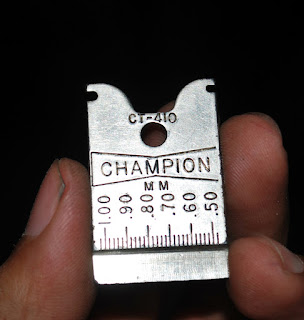It's pretty easy to do with just some basic tools and a little time and effort, yet I have even read that there are some so called mechanics out there who do not know how to do this (change your mechanic!) or worse claim to know but set it all wrong.
So, here goes...
Valve clearance setting only applies to engines that use solid lifters. If the engine uses a hydraulic lifters the procedure is very different (although easier!) it's something I can teach show some other time.
After the obvious like shutting off the engine and removing the necessary parts to get access to the rocker arms. The first step to setting the valve clearances properly is to understand the concept of Top Dead Center (TDC) sometimes called the Zero Setting by others. This is also useful in setting other timing related components of the engine like the ignition, timing belt and the distributor. at TDC the #1 piston will be at the very top of it's compression stroke. That is at the point where it has finished travelling upward, compressing the air/fuel mixture and will begin travelling downward. There are 3 indicators that the engine is at this position. These will vary slightly from engine to engine but more or less all engine have some marking to identify these.
The notch of the crank pulley, painted in white to enhance contrast against the black pulley. will align with the 'T' mark on the timing cover. This T is sometimes 0 (zero) in other engines.
A mark on the cam gear (a dot in this case) will align to a mark on top of the case. This is important because the crank pulley will pass thru it's top dead center mark twice before the cam gear aligns to its mark at TDC. This is because the camshaft is driven a 50% of the crank shaft speed. So just because the crank pulley is aligned at T, it does not mean the engine will be at TDC.
The valves of the #4 cylinder will be 'on the rock'. This means that the lobe of the the intake valve will be just about to close the valve while the exhaust will be just about to open. You may need a sharp eye to spot this, it's very obvious here with my 4G33 because the Rally Cam has a lot of valve over lap so the time the intake and exhaust are open together is longer and thus its being on the rock is easy to spot.
Rotate the engine in it's normal direction of rotation (avoid going backwards as much as possible) until it is set to top dead center. This is usually clockwise save for a few (like Honda engines) that rotate anti-clockwise. In a FWD car with a transverse engine there will be a slot on the side of the wheel well where you can stick a socket wrench through to rotate the engine.
Before we begin setting the valves it is important to be familiar with the 'on the rock' position and the pistons running mates. TDC is easy to find because it has it's markings and will let us set the valves of the #1 piston. But the other pistons being at top dead center will rely on being able to spot if its running mate is on the rock. In almost all 4 cylinder engines #1 and #4 run together while #3 and #2 run together. That is they will be both at the top or bottom of their stroke together.
Now we can start setting the valve clearances. It is important to use a good quality set of feeler gauges for this. I set my engines to 0.007 inches for the intake and 0.011 inches for the exhaust. For performance tuning we can have a long discussion about what clearances to run, but for now I would suggest to use whatever the factory spec is for your car. Note also that this is a cold setting. The valve clearances for a hot engine will be looser due to thermal expansion although I don't know why you would want to work on a hot engine.
With the engine set to TDC the valves of the #1 cylinder can be adjusted. Loosen the nut on top of the rocker arm...
... and use a flat screw driver to turn the adjustment screw in or out until the desired valve clearance is achieved. This should be set where the feeler gauge can just barely slide in and out from between the rocker arm (that's why my gauges have a bit of scratches on my favorite settings). Holding the adjustment screw steady with the screw driver, re-tighten the nut and then double check that the clearance has not changed. Do this for intake and exhaust of the #1 cylinder.
With the valves of #1 adjusted it will be time to adjust the next cylinder in the firing order. It's 1-3-4-2 for most 4 cylinder engines (check yours to be sure!) so #3 gets adjusted next. The running mate of #3 is #2, so watch for the valves of the #2 cylinder to be on the rock. After adjusting #3, rotate the engine again to adjust #4. In this position it's running mate, #1 will be on the rock. The finally rotate the engine again to adjust #2, watch for when it's partner #3 is on the rock. The you're done.
If that last paragraph maybe a bit confusing refer to this;
- Adjust #1 cylinder when; Crank pulley and cam gear are at TDC, #4 cylinder is on the rock.
- Adjust #3 cylinder when #2 cylinder is on the rock.
- Adjust #4 cylinder when #1 cylinder is on the rock.
- Adjust #2 cylinder when #3 cylinder is on the rock.












